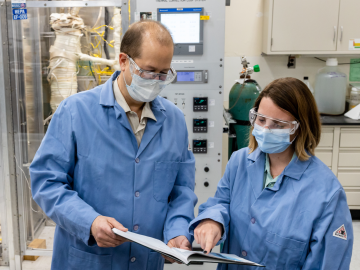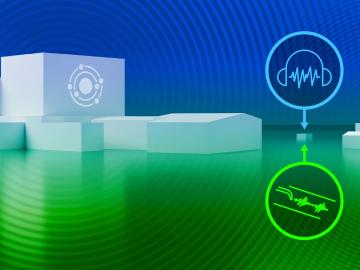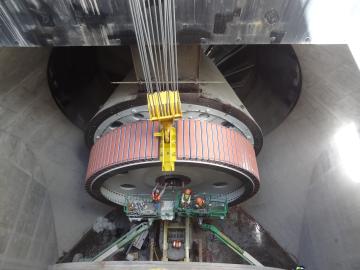
Filter News
Area of Research
- Advanced Manufacturing (3)
- Biology and Environment (17)
- Electricity and Smart Grid (1)
- Energy Science (24)
- Functional Materials for Energy (1)
- Fusion and Fission (8)
- Fusion Energy (1)
- Materials (18)
- Materials for Computing (1)
- National Security (9)
- Neutron Science (2)
- Nuclear Science and Technology (1)
- Supercomputing (11)
News Topics
- (-) 3-D Printing/Advanced Manufacturing (13)
- (-) Clean Water (5)
- (-) Fusion (8)
- (-) Grid (13)
- (-) Machine Learning (10)
- (-) Physics (10)
- (-) Quantum Science (9)
- Advanced Reactors (4)
- Artificial Intelligence (14)
- Big Data (9)
- Bioenergy (19)
- Biology (28)
- Biomedical (6)
- Biotechnology (3)
- Buildings (16)
- Chemical Sciences (15)
- Composites (3)
- Computer Science (20)
- Coronavirus (9)
- Critical Materials (5)
- Cybersecurity (7)
- Element Discovery (1)
- Energy Storage (25)
- Environment (36)
- Exascale Computing (8)
- Fossil Energy (1)
- Frontier (10)
- High-Performance Computing (16)
- Hydropower (8)
- Irradiation (1)
- Isotopes (4)
- ITER (2)
- Materials (37)
- Materials Science (18)
- Mercury (1)
- Microscopy (13)
- Nanotechnology (9)
- National Security (17)
- Neutron Science (12)
- Nuclear Energy (13)
- Partnerships (8)
- Polymers (5)
- Quantum Computing (7)
- Security (4)
- Simulation (6)
- Space Exploration (6)
- Summit (7)
- Transportation (10)
Media Contacts

Practical fusion energy is not just a dream at ORNL. Experts in fusion and material science are working together to develop solutions that will make a fusion pilot plant — and ultimately carbon-free, abundant fusion electricity — possible.

The Frontier supercomputer at the Department of Energy’s Oak Ridge National Laboratory earned the top ranking today as the world’s fastest on the 59th TOP500 list, with 1.1 exaflops of performance. The system is the first to achieve an unprecedented level of computing performance known as exascale, a threshold of a quintillion calculations per second.

How an Alvin M. Weinberg Fellow is increasing security for critical infrastructure components

To achieve practical energy from fusion, extreme heat from the fusion system “blanket” component must be extracted safely and efficiently. ORNL fusion experts are exploring how tiny 3D-printed obstacles placed inside the narrow pipes of a custom-made cooling system could be a solution for removing heat from the blanket.

What’s getting Jim Szybist fired up these days? It’s the opportunity to apply his years of alternative fuel combustion and thermodynamics research to the challenge of cleaning up the hard-to-decarbonize, heavy-duty mobility sector — from airplanes to locomotives to ships and massive farm combines.

Researchers at ORNL are teaching microscopes to drive discoveries with an intuitive algorithm, developed at the lab’s Center for Nanophase Materials Sciences, that could guide breakthroughs in new materials for energy technologies, sensing and computing.

Scientists are using Oak Ridge National Laboratory’s Multicharged Ion Research Facility to simulate the cosmic origin of X-ray emissions resulting when highly charged ions collide with neutral atoms and molecules, such as helium and gaseous hydrogen.

An Oak Ridge National Laboratory team developed a novel technique using sensors to monitor seismic and acoustic activity and machine learning to differentiate operational activities at facilities from “noise” in the recorded data.

A team of researchers has developed a novel, machine learning–based technique to explore and identify relationships among medical concepts using electronic health record data across multiple healthcare providers.

A new Department of Energy report produced by Oak Ridge National Laboratory identifies several supply chain must-haves in maintaining the pivotal role hydropower will play in decarbonizing the nation’s grid.


